Plastic Waste Management: A Bibliometric Analysis (1992–2022)
Abstract
:1. Introduction
2. Materials and Methods
2.1. Data Collection
2.2. Bibliometric Mapping and Analysis
3. Results and Discussion
3.1. Data Sources
3.2. Author, Affiliations, and Countries
3.3. Top Cited Publications
3.4. Current and Future Trends
4. Conclusions
Author Contributions
Funding
Institutional Review Board Statement
Informed Consent Statement
Data Availability Statement
Conflicts of Interest
References
- Plastics Europe. Plastics-the Facts 2010. An Analysis of European Plastics Production, Demand and Recovery for 2009. 2010. Available online: https://www.plasticseurope.org/en/resources/publications/171-plastics-facts-2010. (accessed on 30 May 2023).
- Thompson, R.C.; Swan, S.H.; Moore, C.J.; Vom Saal, F.S. Our plastic age. Philos. Trans. R. Soc. B Biol. Sci. 2009, 364, 1973–1976. [Google Scholar] [CrossRef] [PubMed]
- Geyer, R.; Jambeck, J.R.; Law, K.L. Production, use, and fate of all plastics ever made. Sci. Adv. 2017, 3, e1700782. [Google Scholar] [CrossRef] [PubMed]
- Bellasi, A.; Binda, G.; Pozzi, A.; Galafassi, S.; Volta, P.; Bettinetti, R. Microplastic contamination in freshwater environments: A review, focusing on interactions with sediments and benthic organisms. Environments 2020, 7, 30. [Google Scholar] [CrossRef]
- Li, C.; Busquets, R.; Campos, L.C. Assessment of microplastics in freshwater systems: A review. Sci. Total Environ. 2020, 707, 135578. [Google Scholar] [CrossRef] [PubMed]
- Xu, S.; Ma, J.; Ji, R.; Pan, K.; Miao, A.J. Microplastics in aquatic environments: Occurrence, accumulation, and biological effects. Sci. Total Environ. 2020, 703, 134699. [Google Scholar] [CrossRef] [PubMed]
- Plastics Europe. Plastics-the Facts 2017 An Analysis of European Plastics Production, Demand and Waste Data. 2018. Available online: https://plasticseurope.org/wp-content/uploads/2021/10/2017-Plastics-the-facts.pdf (accessed on 30 May 2023).
- OECD. Plastic Pollution Is Growing Relentlessly as Waste Management and Recycling Fall Short, Says OECD 2022. 2022. Available online: https://www.oecd.org/environment/plastic-pollution-is-growing-relentlessly-as-waste-management-and-recycling-fall-short.htm (accessed on 20 June 2023).
- Kasavan, S.; Yusoff, S.; Rahmat Fakri, M.F.; Siron, R. Plastic pollution in water ecosystems: A bibliometric analysis from 2000 to 2020. J. Clean. Prod. 2021, 313, 127946. [Google Scholar] [CrossRef]
- Khatun, R.; Xiang, H.; Yang, Y.; Wang, J.; Yildiz, G. Bibliometric analysis of research trends on the thermochemical conversion of plastics during 1990–2020. J. Clean. Prod. 2021, 317, 128373. [Google Scholar] [CrossRef]
- Armenise, S.; SyieLuing, W.; Ramírez-Velásquez, J.M.; Launay, F.; Wuebben, D.; Ngadi, N.; Rams, J.; Muñoz, M. Plastic waste recycling via pyrolysis: A bibliometric survey and literature review. J. Anal. Appl. Pyrolysis 2021, 158, 105265. [Google Scholar] [CrossRef]
- Akinpelu, E.A.; Nchu, F. A Bibliometric Analysis of Research Trends in Biodegradation of Plastics. Polymers 2022, 14, 2642. [Google Scholar] [CrossRef]
- Yang, S.S.; Wu, W.M.; Pang, J.W.; He, L.; Ding, M.Q.; Li, M.X.; Zhao, Y.L.; Sun, H.J.; Xing, D.F.; Ren, N.Q.; et al. Bibliometric analysis of publications on biodegradation of plastics: Explosively emerging research over 70 years. J. Clean. Prod. 2023, 428, 139423. [Google Scholar] [CrossRef]
- Nabgan, W.; Ikram, M.; Alhassan, M.; Owgi, A.H.K.; Van Tran, T.; Parashuram, L.; Nordin, A.H.; Djellabi, R.; Jalil, A.A.; Medina, F.; et al. Bibliometric analysis and an overview of the application of the non-precious materials for pyrolysis reaction of plastic waste. Arab. J. Chem. 2023, 16, 104717. [Google Scholar] [CrossRef]
- Hirsch, J.E. An index to quantify an individual’s scientific research output. Proc. Natl. Acad. Sci. USA 2005, 102, 16569–16572. [Google Scholar] [CrossRef] [PubMed]
- Merigó, J.M.; Gil-Lafuente, A.M.; Yager, R.R. An overview of fuzzy research with bibliometric indicators. Appl. Soft Comput. 2015, 27, 420–433. [Google Scholar] [CrossRef]
- Li, K.; Rollins, J.; Yan, E. Web of Science use in published research and review papers 1997–2017: A selective, dynamic, cross-domain, content-based analysis. Scientometrics 2018, 115, 1–20. [Google Scholar] [CrossRef] [PubMed]
- Braun, A.B.; Trentin, A.W.; da Silva Trentin, A.W.; Visentin, C.; Thomé, A. Sustainable remediation through the risk management perspective and stakeholder involvement: A systematic and bibliometric view of the literature. Environ. Pollut. 2019, 255, 113221. [Google Scholar] [CrossRef] [PubMed]
- Wong, S.L.; Mong, G.R.; Nyakuma, B.B.; Ngadi, N.; Wong, K.Y.; Hernández, M.M.; Armenise, S.; Chong, C.T. Upcycling of plastic waste to carbon nanomaterials: A bibliometric analysis (2000–2019). Clean. Technol. Environ. Policy 2022, 24, 739–759. [Google Scholar] [CrossRef]
- Jiménez-García, M.; Ruiz-Chico, J.; Peña-Sánchez, A.R.; López-Sánchez, J.A. A bibliometric analysis of sports tourism and sustainability (2002–2019). Sustainability 2020, 12, 2840. [Google Scholar] [CrossRef]
- van Eck, N.J. Methodological Advances in Bibliometric Mapping and Science. Ph.D. Thesis, Erasmus Universiteit Rotterdam, Rotterdam, The Netherlands, 2011. Available online: http://hdl.handle.net/1765/26509 (accessed on 23 March 2023).
- van Eck, N.J.; Waltman, L. Bibliometric Mapping of The Computational Intelligence Field. Int. J. Uncertain. 2007, 15, 625–645. [Google Scholar] [CrossRef]
- van Eck, N.J.; Waltman, L.; Noyons, E.C.M.; Buter, R.K. Automatic term identification for bibliometric mapping. Scientometrics 2010, 82, 581–596. [Google Scholar] [CrossRef]
- van Eck, N.J.; Waltman, L. VOSviewer Manual. Leiden. 2013. Available online: https://www.vosviewer.com/documentation/Manual_VOSviewer_1.5.4.pdf (accessed on 22 March 2023).
- Waaijer, C.J.F.; van Bochove, C.A.; van Eck, N.J. On the map: Nature and Science editorials. Scientometrics 2011, 86, 99–112. [Google Scholar] [CrossRef]
- van Eck, N.J.; Waltman, L. Software survey: VOSviewer, a computer program for bibliometric mapping. Scientometrics 2010, 84, 523–538. [Google Scholar] [CrossRef]
- van Eck, N.J.; Waltman, L. VOSviewer Manual. 2019. Available online: https://www.vosviewer.com/documentation/Manual_VOSviewer_1.6.13.pdf (accessed on 27 March 2023).
- Chang, K.; Tao, J.; Fang, C.; Li, J.; Zhou, W.; Wang, X.; Yan, B.; Zeng, D.; Chen, G. Evolution of research topics on the Tibetan Plateau environment and ecology from 2000 to 2020: A paper mining. Environ. Sci. Pollut. Res. 2022, 29, 12933–12947. [Google Scholar] [CrossRef]
- Paquibut, R.Y.; Legion, M.C.; Islam, A.R.M.; Chaudhry, I.S.; Gernal, L. Sustainable plastics waste management framework based on the analysis of people’s awareness, knowledge, attitude, skills, and action: Development of sustainable plastics waste management approaches. Int. J. Environ. Sci. Technol. 2023, 20, 10217–10228. [Google Scholar] [CrossRef]
- Shilpa, Basak, N.; Meena, S.S. Microbial biodegradation of plastics: Challenges, opportunities, and a critical perspective. Front. Environ. Sci. Eng. 2022, 16, 161. [Google Scholar] [CrossRef] [PubMed]
- Swain, D.K. Journal Bibliometric Analysis: A Case Study on Internet Research. Libr. Philos. Pract. 2013, 985, 1–23. [Google Scholar]
- Podsakoff, P.M.; MacKenzie, S.B.; Podsakoff, N.P.; Bachrach, D.G. Scholarly influence in the field of management: A bibliometric analysis of the determinants of University and author impact in the management literature in the past quarter century. J. Manag. 2008, 34, 641–720. [Google Scholar] [CrossRef]
- Bonilla, C.A.; Merigó, J.M.; Torres-Abad, C. Economics in Latin America: A bibliometric analysis. Scientometrics 2015, 105, 1239–1252. [Google Scholar] [CrossRef]
- Montalván-Burbano, N.; Pérez-Valls, M.; Plaza-Úbeda, J. Analysis of scientific production on organizational innovation. Cogent Bus. Manag. 2020, 7, 1745043. [Google Scholar] [CrossRef]
- Ellegaard, O.; Wallin, J.A. The bibliometric analysis of scholarly production: How great is the impact. Scientometrics 2015, 105, 1809–1831. [Google Scholar] [CrossRef] [PubMed]
- de Sousa, F.D.B. Management of plastic waste: A bibliometric mapping and analysis. Waste Manag. Res. 2021, 39, 664–678. [Google Scholar] [CrossRef]
- Zhang, J.; Quoquab, F.; Mohammad, J. Plastic and sustainability: A bibliometric analysis using VOSviewer and CiteSpace. Arab. Gulf J. Sci. Res. 2023. ahead of print. [Google Scholar] [CrossRef]
- Jambeck, J.R.; Geyer, R.; Wilcox, C.; Siegler, T.R.; Perryman, M.; Andrady, A.; Narayan, R.; Law, K.L. Plastic waste inputs from land into the ocean. Science 2015, 347, 768–771. [Google Scholar] [CrossRef]
- Wright, S.L.; Kelly, F.J. Plastic and human health: A micro issue. Environ. Sci. Technol. 2017, 51, 6634–6647. [Google Scholar] [CrossRef]
- Farrukh, M.; Meng, F.; Raza, A.; Tahir, M.S. Twenty-seven years of Sustainable Development Journal: A bibliometric analysis. Sustain. Dev. 2020, 28, 1725–1737. [Google Scholar] [CrossRef]
- Tsay, M.-Y.; Shu, Z.-Y. Journal bibliometric analysis: A case study on the Journal of Documentation. J. Doc. 2011, 67, 806–822. [Google Scholar] [CrossRef]
- Horton, A.A.; Walton, A.; Spurgeon, D.J.; Lahive, E.; Svendsen, C. Microplastics in freshwater and terrestrial environments: Evaluating the current understanding to identify the knowledge gaps and future research priorities. Sci. Total Environ. 2017, 586, 127–141. [Google Scholar] [CrossRef]
- Lebreton, L.C.M.; Van Der Zwet, J.; Damsteeg, J.W.; Slat, B.; Andrady, A.; Reisser, J. River plastic emissions to the world’s oceans. Nat. Commun. 2017, 8, 15611. [Google Scholar] [CrossRef]
- Zhu, Y.; Romain, C.; Williams, C.K. Sustainable polymers from renewable resources. Nature 2016, 540, 354–362. [Google Scholar] [CrossRef] [PubMed]
- Auta, H.S.; Emenike, C.U.; Fauziah, S.H. Distribution and importance of microplastics in the marine environmentA review of the sources, fate, effects, and potential solutions. Environ. Int. 2017, 102, 165–176. [Google Scholar] [CrossRef] [PubMed]
- Hahladakis, J.N.; Velis, C.A.; Weber, R.; Iacovidou, E.; Purnell, P. An overview of chemical additives present in plastics: Migration, release, fate and environmental impact during their use, disposal and recycling. J. Hazard. Mater. 2018, 344, 179–199. [Google Scholar] [CrossRef]
- Haider, T.P.; Völker, C.; Kramm, J.; Landfester, K.; Wurm, F.R. Kunststoffe der Zukunft? Der Einfluss von bioabbaubaren Polymeren auf Umwelt und Gesellschaft. Angew. Chem. 2019, 131, 50–63. [Google Scholar] [CrossRef]
- Wright, S.L.; Thompson, R.C.; Galloway, T.S. The physical impacts of microplastics on marine organisms: A review. Environ. Pollut. 2013, 178, 483–492. [Google Scholar] [CrossRef] [PubMed]
- Cózar, A.; Echevarría, F.; González-Gordillo, J.I.; Irigoien, X.; Úbeda, B.; Hernández-León, S.; Palma, Á.T.; Navarro, S.; García-de-Lomas, J.; Ruiz, A.; et al. Plastic debris in the open ocean. Proc. Natl. Acad. Sci. USA 2014, 111, 10239–10244. [Google Scholar] [CrossRef] [PubMed]
- Gall, S.C.; Thompson, R.C. The impact of debris on marine life. Mar. Pollut. Bull. 2015, 92, 170–179. [Google Scholar] [CrossRef]
- Li, W.C.; Tse, H.F.; Fok, L. Plastic waste in the marine environment: A review of sources, occurrence and effects. Sci. Total Environ. 2016, 566–567, 333–349. [Google Scholar] [CrossRef] [PubMed]
- Lebreton, L.; Slat, B.; Ferrari, F.; Sainte-Rose, B.; Aitken, J.; Marthouse, R.; Hajbane, S.; Cunsolo, S.; Schwarz, A.; Levivier, A.; et al. Evidence that the Great Pacific Garbage Patch is rapidly accumulating plastic. Sci. Rep. 2018, 8, 4666. [Google Scholar] [CrossRef]
- Anuar Sharuddin, S.D.; Abnisa, F.; Wan Daud, W.M.A.; Aroua, M.K. A review on pyrolysis of plastic wastes. Energy Convers. Manag. 2016, 115, 308–326. [Google Scholar] [CrossRef]
- Ragaert, K.; Delva, L.; Van Geem, K. Mechanical and chemical recycling of solid plastic waste. Waste Manag. 2017, 69, 24–58. [Google Scholar] [CrossRef]
- Li, J.; Liu, H.; Chen, J.P. Microplastics in freshwater systems: A review on occurrence, environmental effects, and methods for microplastics detection. Water Res. 2018, 137, 362–374. [Google Scholar] [CrossRef]
- Borrelle, S.B.; Ringma, J.; Law, K.L.; Monnahan, C.C.; Lebreton, L.; Mcgivern, A.; Murphy, E.; Jambeck, J.; Leonard, G.H.; Hilleary, M.A.; et al. Predicted growth in plastic waste exceeds efforts to mitigate plastic pollution. Science 2020, 369, 1515–1518. [Google Scholar] [CrossRef]
- Vošner, H.B.; Kokol, P.; Bobek, S.; Železnik, D.; Završnik, J. A bibliometric retrospective of the Journal Computers in Human Behavior (1991–2015). Comput. Human Behav. 2016, 65, 46–58. [Google Scholar] [CrossRef]
- Miao, C.; Humphrey, R.H.; Qian, S. A meta-analysis of emotional intelligence effects on job satisfaction mediated by job resources, and a test of moderators. Personal. Individ. Differ. 2017, 116, 281–288. [Google Scholar] [CrossRef]
- Zheng, K.; Wang, X. Publications on the association between cognitive function and pain from 2000 to 2018: A bibliometric analysis using Citespace. Med. Sci. Monit. 2019, 25, 8940–8951. [Google Scholar] [CrossRef]
- Singh, N.; Hui, D.; Singh, R.; Ahuja, I.P.S.; Feo, L.; Fraternali, F. Recycling of plastic solid waste: A state of art review and future applications. Compos. B Eng. 2017, 115, 409–422. [Google Scholar] [CrossRef]
- Qureshi, M.S.; Oasmaa, A.; Pihkola, H.; Deviatkin, I.; Tenhunen, A.; Mannila, J.; Minkkinen, H.; Pohjakallio, M.; Laine-Ylijoki, J. Pyrolysis of plastic waste: Opportunities and challenges. J. Anal. Appl. Pyrolysis 2020, 152, 104804. [Google Scholar] [CrossRef]
- Blettler, M.C.M.; Abrial, E.; Khan, F.R.; Sivri, N.; Espinola, L.A. Freshwater plastic pollution: Recognizing research biases and identifying knowledge gaps. Water Res. 2018, 143, 416–424. [Google Scholar] [CrossRef]
- Cole, M.; Lindeque, P.; Halsband, C.; Galloway, T.S. Microplastics as contaminants in the marine environment: A review. Mar. Pollut. Bull. 2011, 62, 2588–2597. [Google Scholar] [CrossRef] [PubMed]
- Thompson, R.C.; Olsen, Y.; Mitchell, R.P.; Davis, A.; Rowland, S.J.; John, A.W.G.; Mcgonigle, D.; Russell, A.E. Lost at Sea: Where Is All the Plastic. Science 2014, 304, 838. [Google Scholar] [CrossRef]
- Haarr, M.L.; Falk-Andersson, J.; Fabres, J. Global marine litter research 2015–2020: Geographical and methodological trends. Sci. Total Environ. 2022, 820, 153162. [Google Scholar] [CrossRef]
- Kumar, A.; Samadder, S.R. A review on technological options of waste to energy for effective management of municipal solid waste. Waste Manag. 2017, 69, 407–422. [Google Scholar] [CrossRef]
- Evode, N.; Qamar, S.A.; Bilal, M.; Barceló, D.; Iqbal, H.M.N. Plastic waste and its management strategies for environmental sustainability. Case Stud. Chem. Environ. Eng. 2021, 4, 100142. [Google Scholar] [CrossRef]
- Rume, T.; Islam, S.M.D.U. Environmental effects of COVID-19 pandemic and potential strategies of sustainability. Heliyon 2020, 6, e04965. [Google Scholar] [CrossRef]
- Vanapalli, K.R.; Sharma, H.B.; Ranjan, V.P.; Samal, B.; Bhattacharya, J.; Dubey, B.K.; Goel, S. Challenges and strategies for effective plastic waste management during and post COVID-19 pandemic. Sci. Total Environ. 2021, 750, 141514. [Google Scholar] [CrossRef]
- Sarkodie, S.A.; Owusu, P.A. Impact of COVID-19 pandemic on waste management. Environ. Dev. Sustain. 2021, 23, 7951–7960. [Google Scholar] [CrossRef] [PubMed]
- El-Shahawi, M.S.; Hamza, A.; Bashammakh, A.S.; Al-Saggaf, W.T. An overview on the accumulation, distribution, transformations, toxicity and analytical methods for the monitoring of persistent organic pollutants. Talanta 2010, 80, 1587–1597. [Google Scholar] [CrossRef]
- Zhang, W.H.; Wu, Y.X.; Simonnot, M.O. Soil Contamination due to E-Waste Disposal and Recycling Activities: A Review with Special Focus on China. Pedosphere 2012, 22, 434–455. [Google Scholar] [CrossRef]
- Ali, M.M.; Ali, M.L.; Islam, M.S.; Rahman, M.Z. Preliminary assessment of heavy metals in water and sediment of Karnaphuli River, Bangladesh. Environ. Nanotechnol. Monit. Manag. 2016, 5, 27–35. [Google Scholar] [CrossRef]
- Bound, J.P.; Voulvoulis, N. Pharmaceuticals in the aquatic environment—A comparison of risk assessment strategies. Chemosphere 2004, 56, 1143–1155. [Google Scholar] [CrossRef]
- Schwab, B.W.; Hayes, E.P.; Fiori, J.M.; Mastrocco, F.J.; Roden, N.M.; Cragin, D.; Meyerhoff, R.D.; D’Aco, V.J.; Anderson, P.D. Human pharmaceuticals in US surface waters: A human health risk assessment. Regul. Toxicol. Pharmacol. 2005, 42, 296–312. [Google Scholar] [CrossRef]
- Liu, J.-L.; Wong, M.-H. Pharmaceuticals and personal care products (PPCPs): A review on environmental contamination in China. Environ. Int. 2013, 59, 208–224. [Google Scholar] [CrossRef]
- Huang, Y.; Chen, Q.; Deng, M.; Japenga, J.; Li, T.; Yang, X.; He, Z. Heavy metal pollution and health risk assessment of agricultural soils in a typical peri-urban area in southeast China. J. Environ. Manag. 2018, 207, 159–168. [Google Scholar] [CrossRef] [PubMed]
- Secondes, M.F.N.; Naddeo, V.; Belgiorno, V.; Ballesteros, F. Removal of emerging contaminants by simultaneous application of membrane ultrafiltration, activated carbon adsorption, and ultrasound irradiation. J. Hazard. Mater. 2014, 264, 342–349. [Google Scholar] [CrossRef] [PubMed]
- Yagub, M.T.; Sen, T.K.; Afroze, S.; Ang, H.M. Dye and its removal from aqueous solution by adsorption: A review. Adv. Colloid Interface Sci. 2014, 209, 172–184. [Google Scholar] [CrossRef]
- Wang, Y.N.; Wang, Q.; Li, Y.; Wang, H.; Gao, Y.; Sun, Y.; Wang, B.; Bian, R.; Li, W.; Zhan, M. Impact of incineration slag co-disposed with municipal solid waste on methane production and methanogens ecology in landfills. Bioresour. Technol. 2023, 377, 128978. [Google Scholar] [CrossRef] [PubMed]
- Yu, Z.; Xu, X.; Guo, L.; Jin, R.; Lu, Y. Uptake and transport of micro/nanoplastics in terrestrial plants: Detection, mechanisms, and influencing factors. Sci. Total Environ. 2023, 907, 168155. [Google Scholar] [CrossRef]
- Ma, M.; Tam, V.W.; Le, K.N.; Butera, A.; Li, W.; Wang, X. Comparative Analysis on International Construction and Demolition Waste Management policies and Laws for Policymakers in China. J. Civ. Eng. Manag. 2023, 292, 107–130. [Google Scholar] [CrossRef]
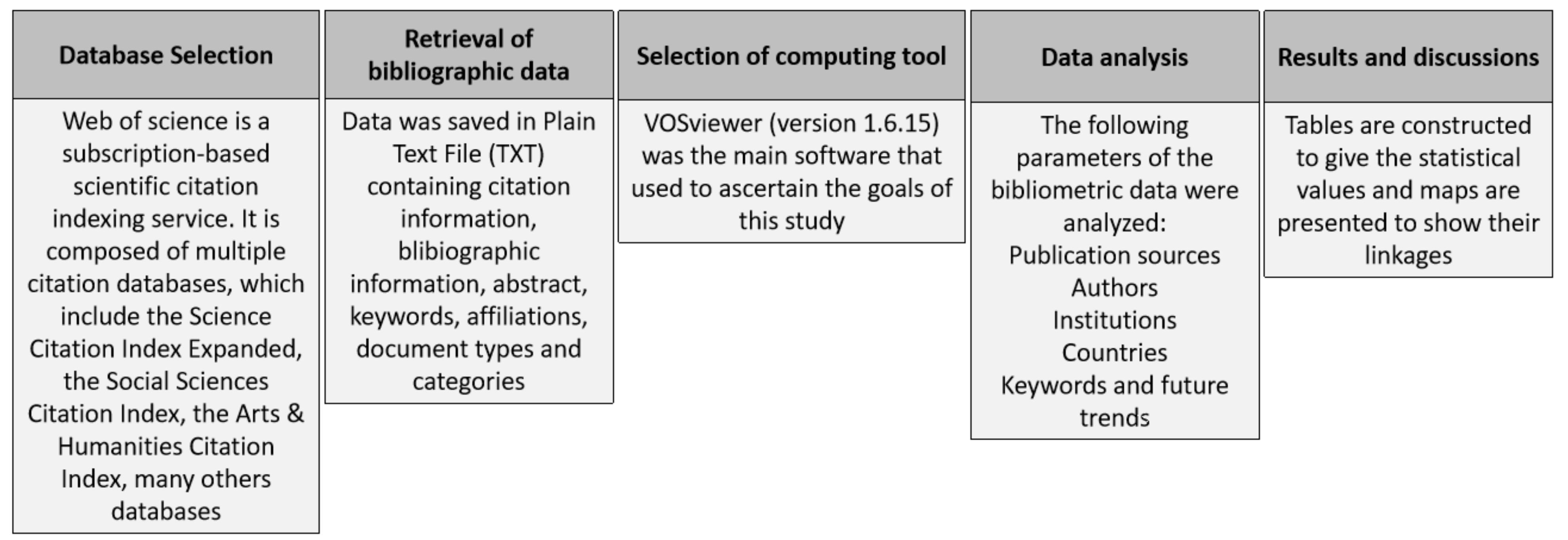
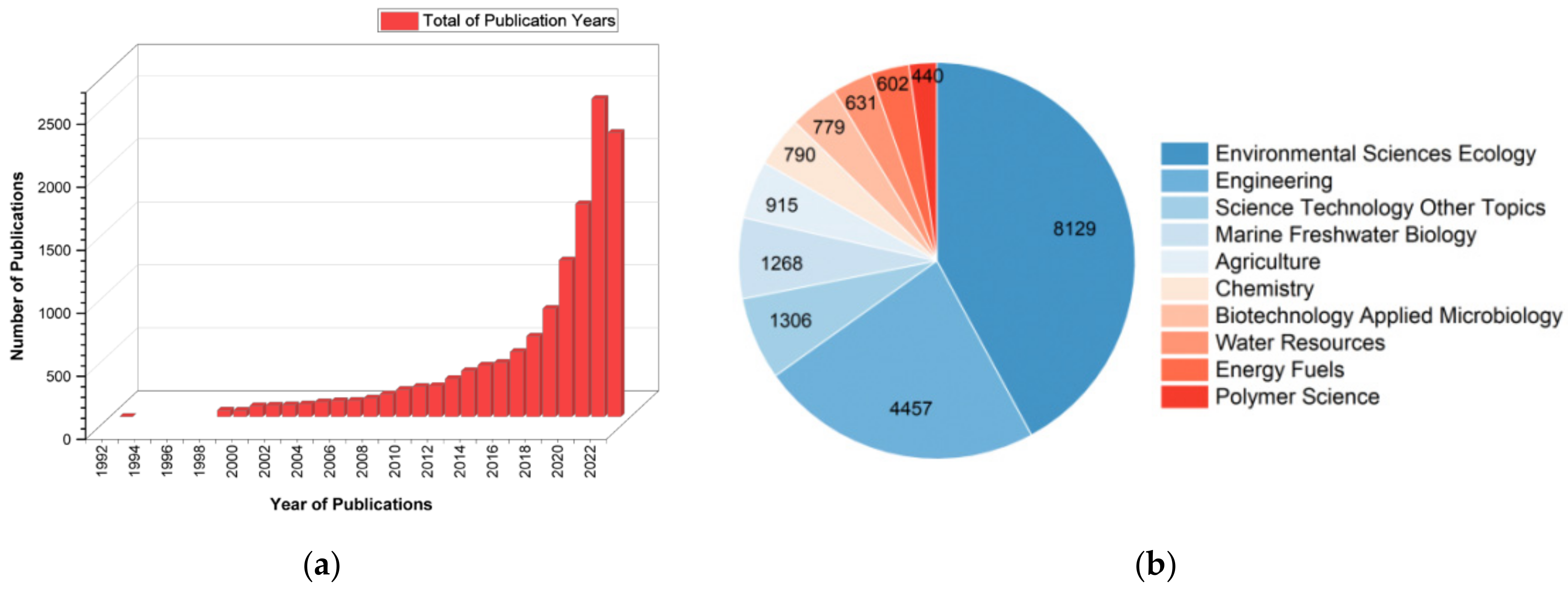
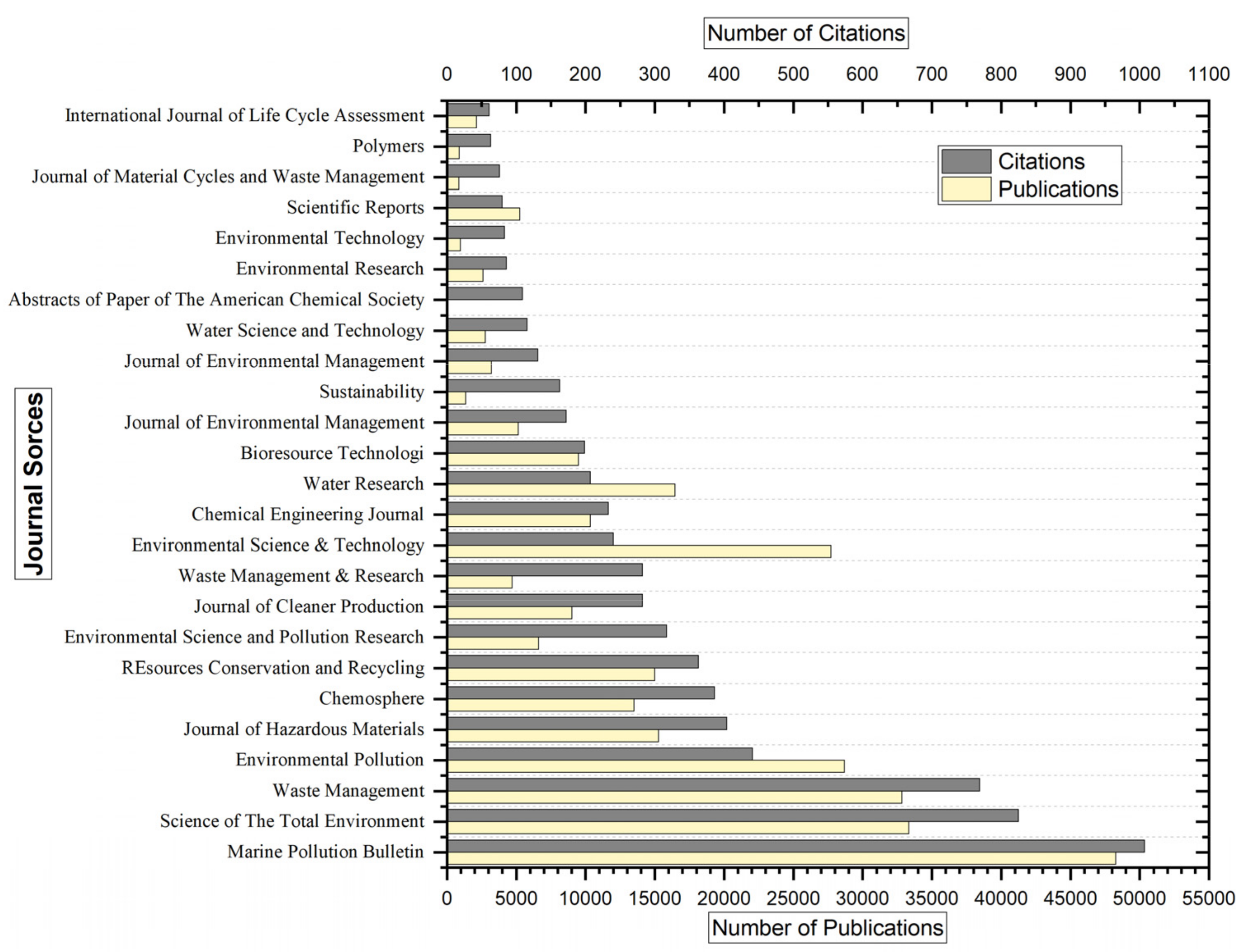
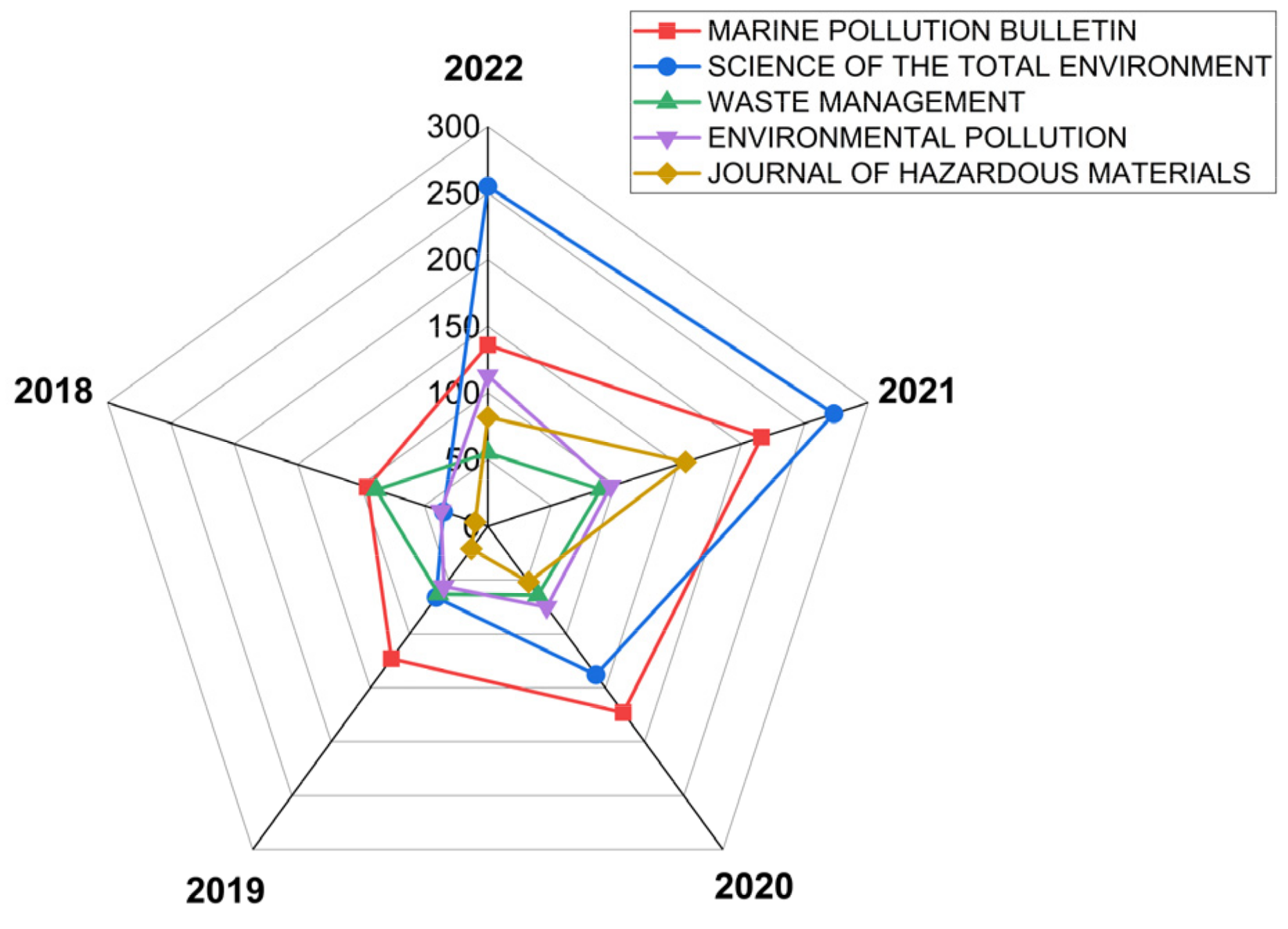
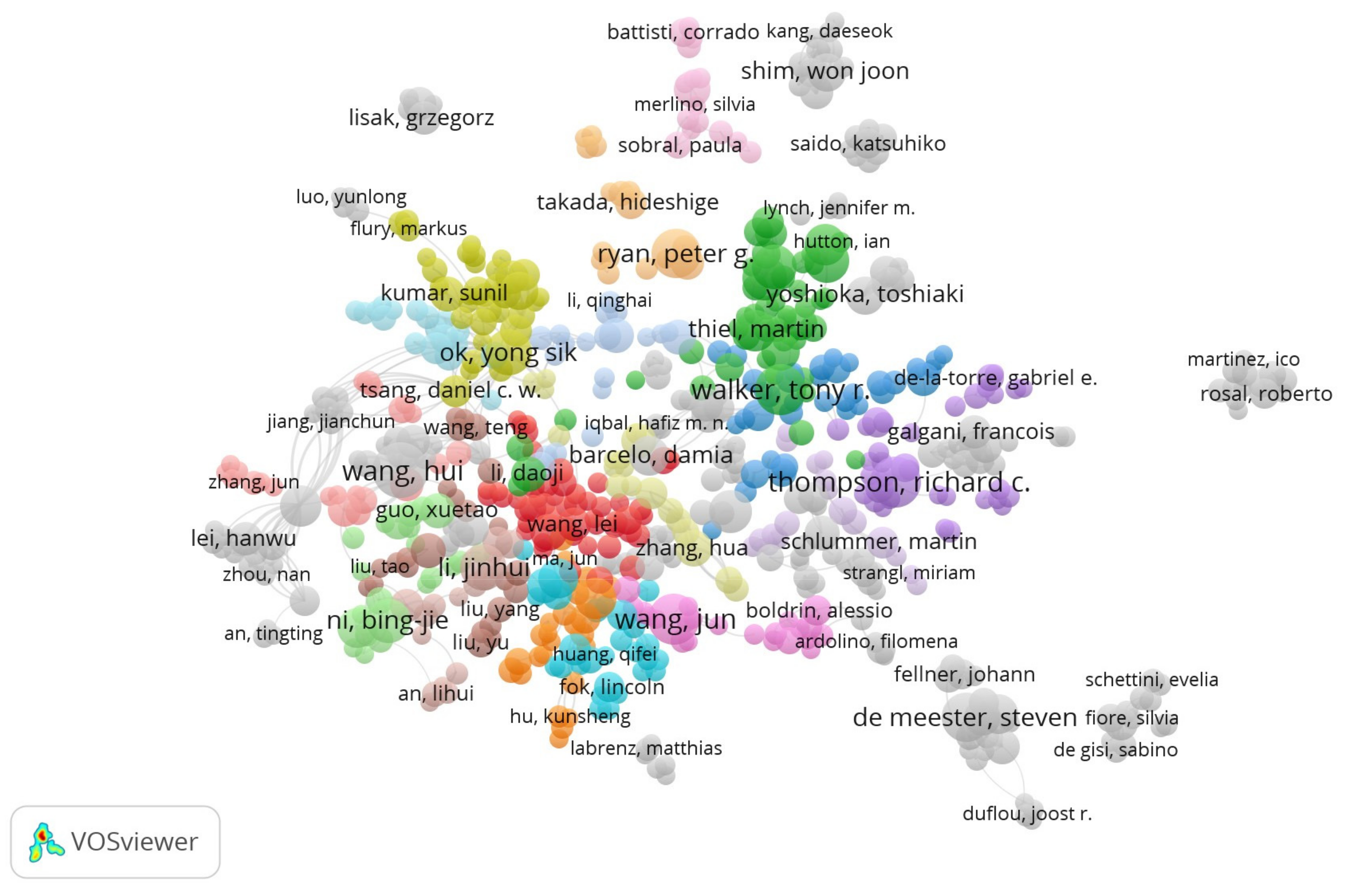
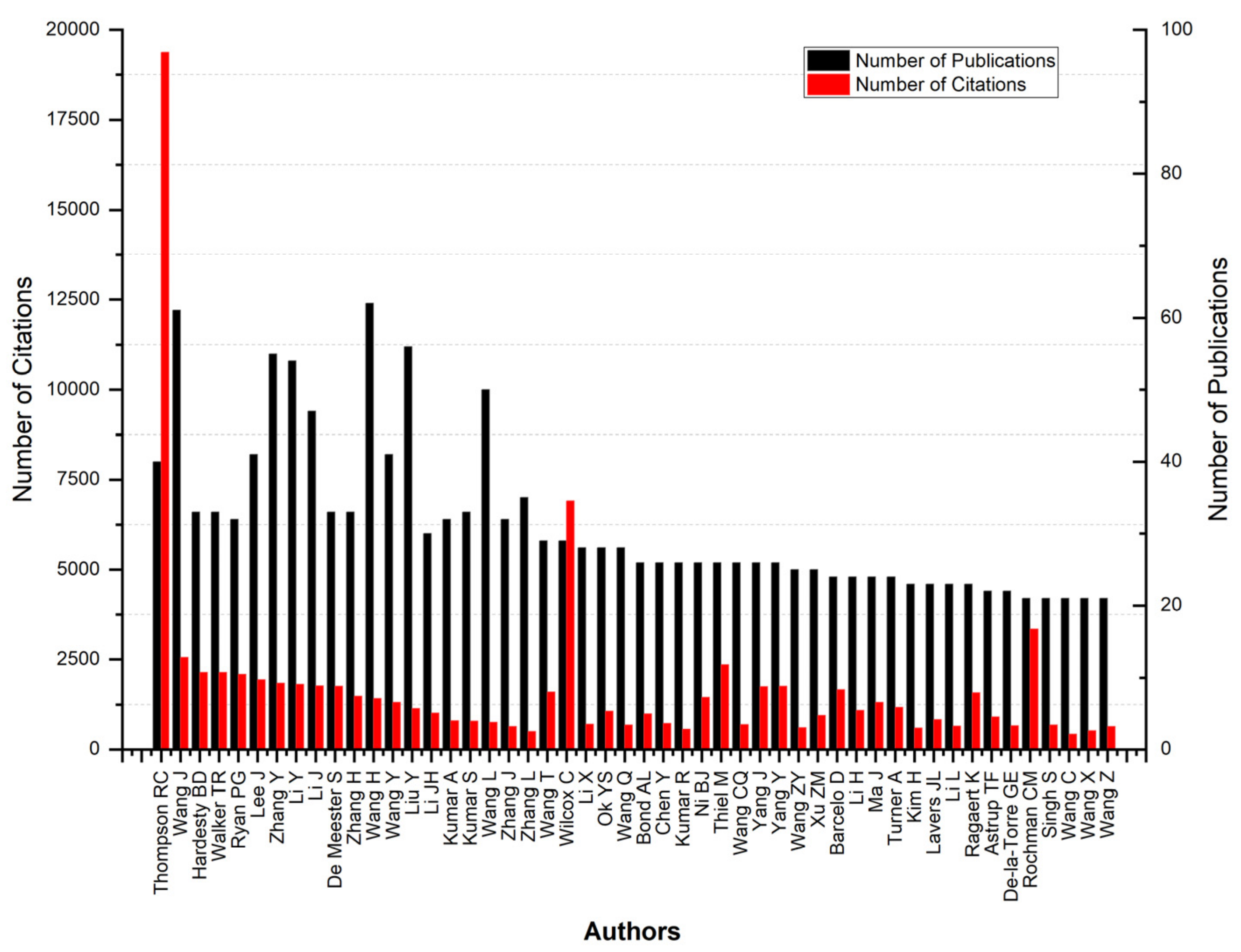


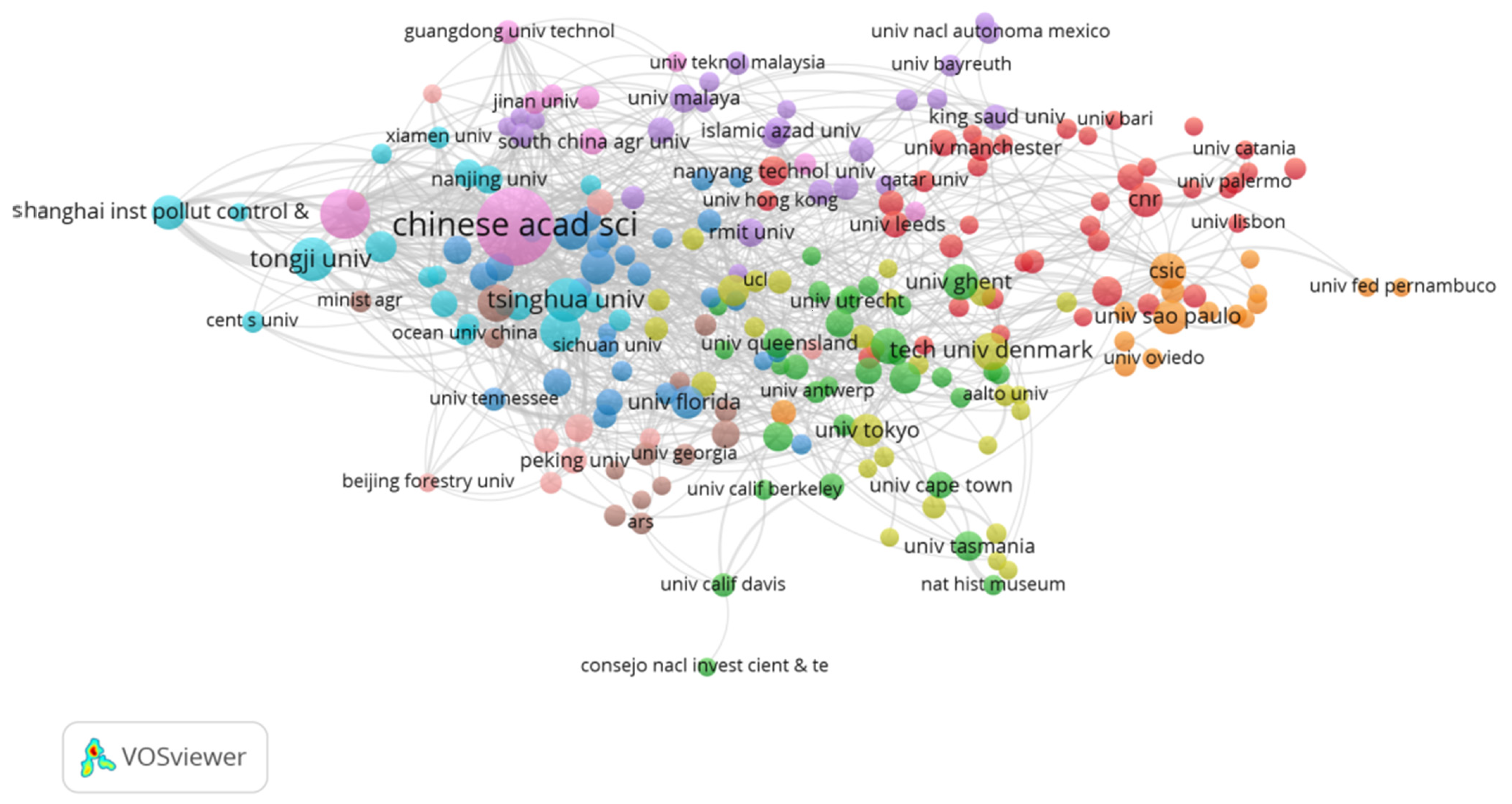
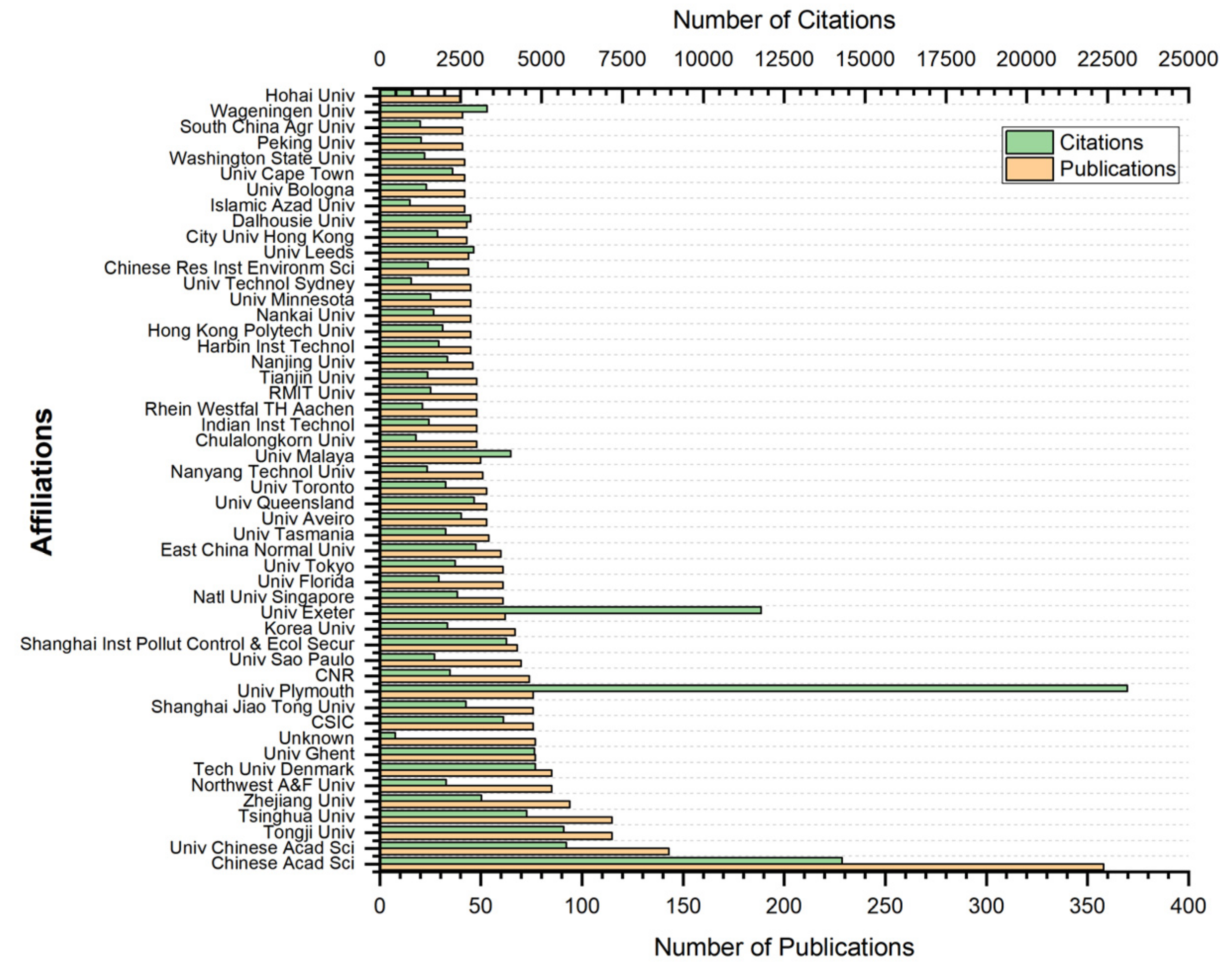

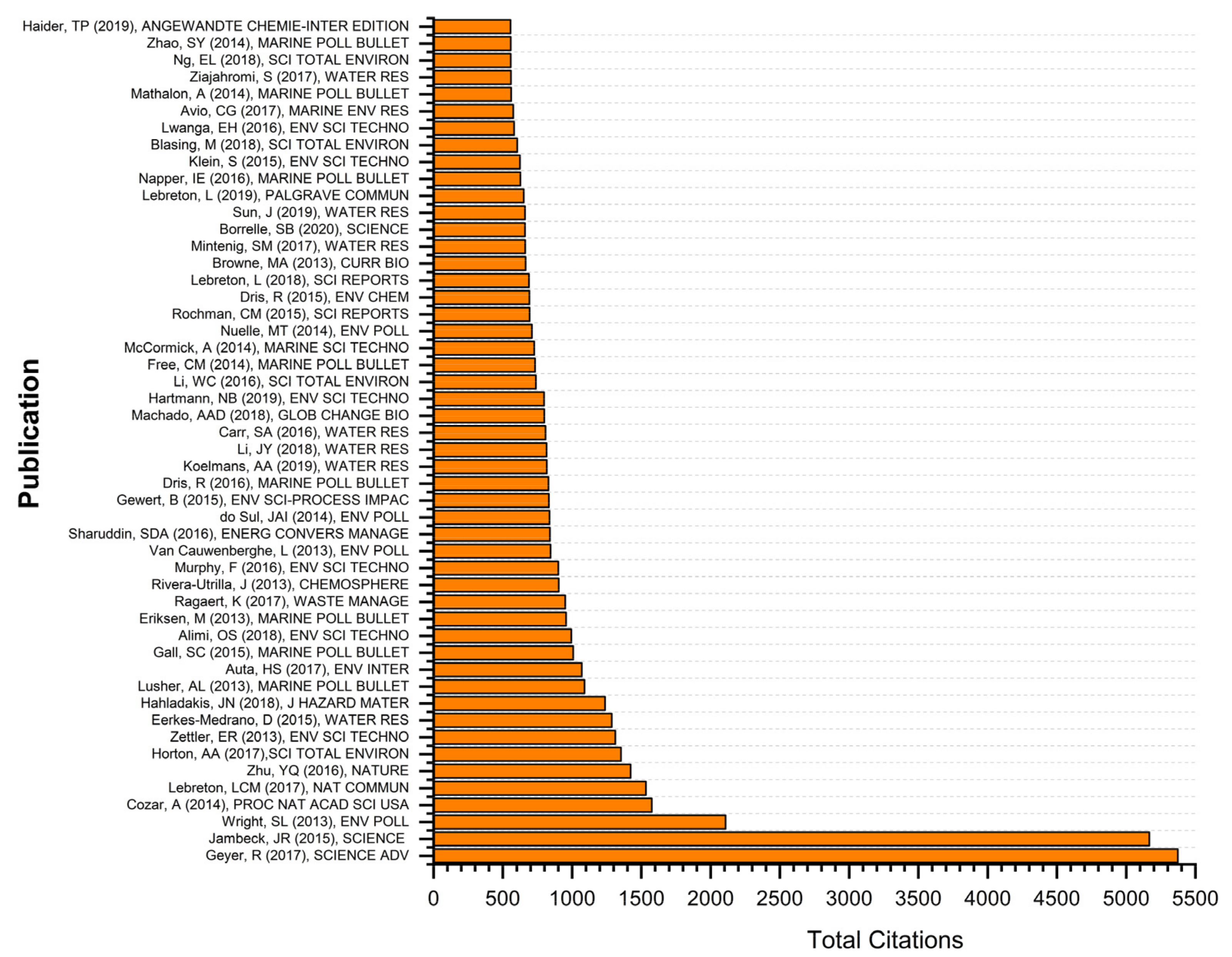
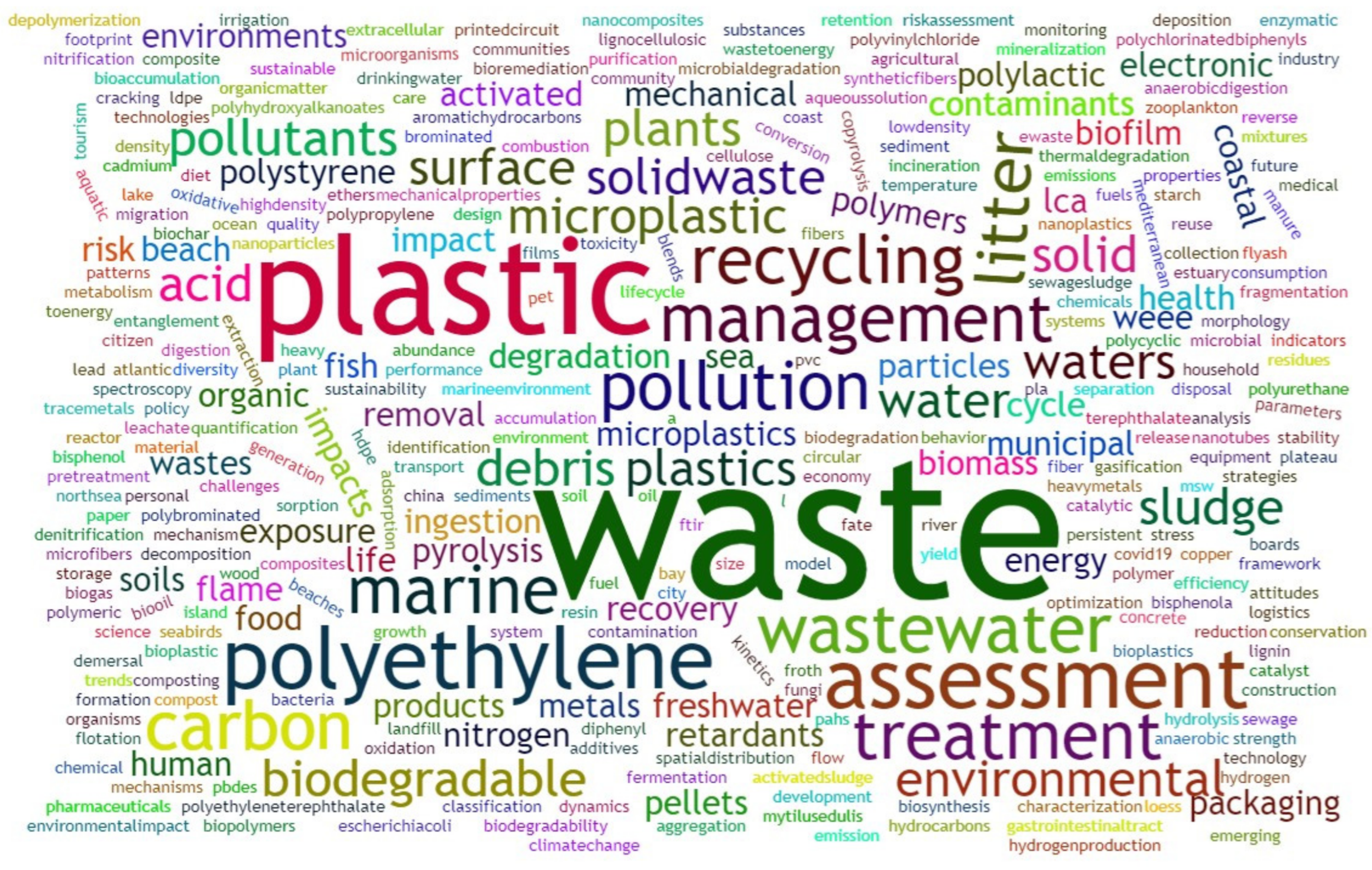
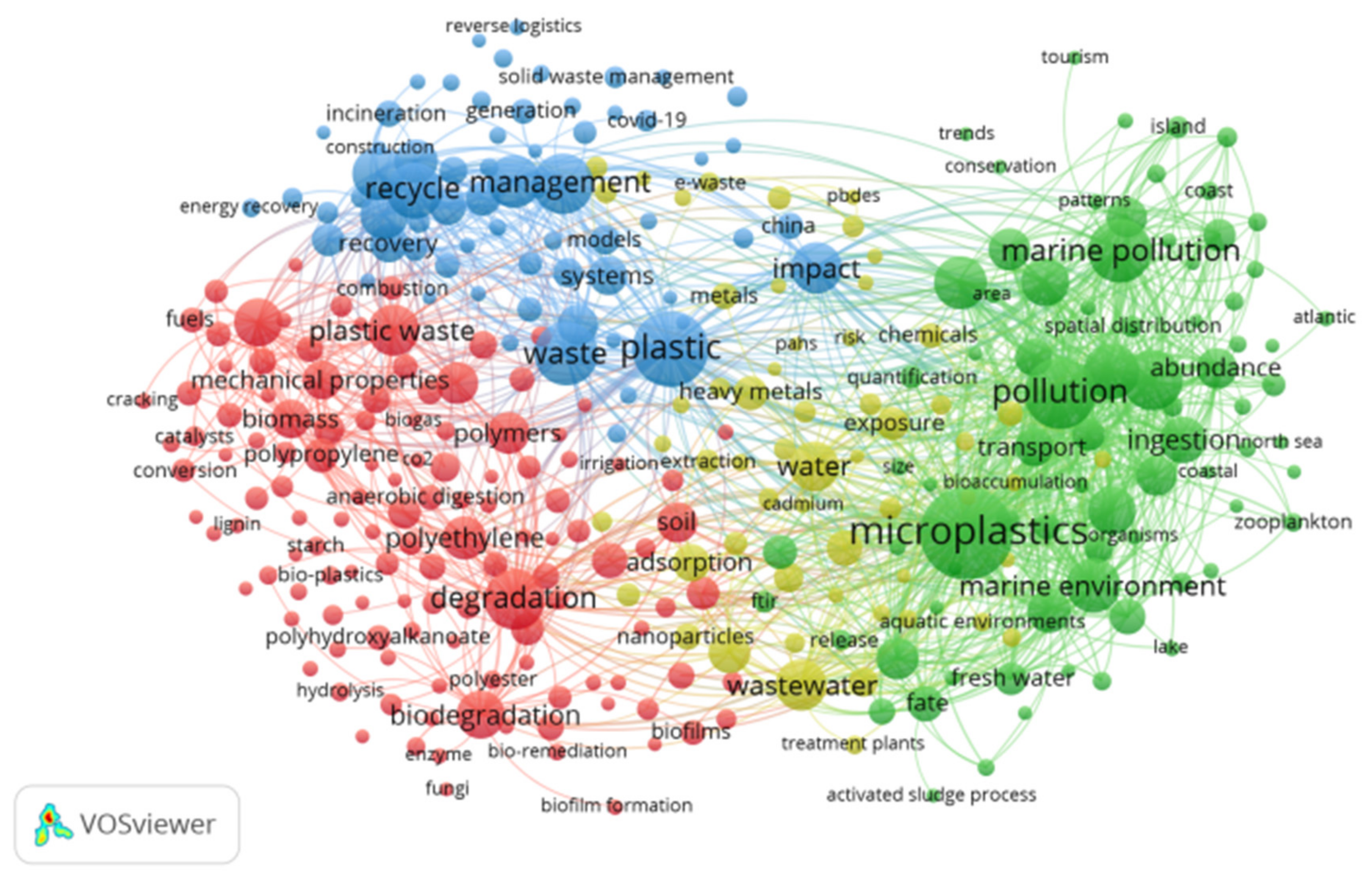
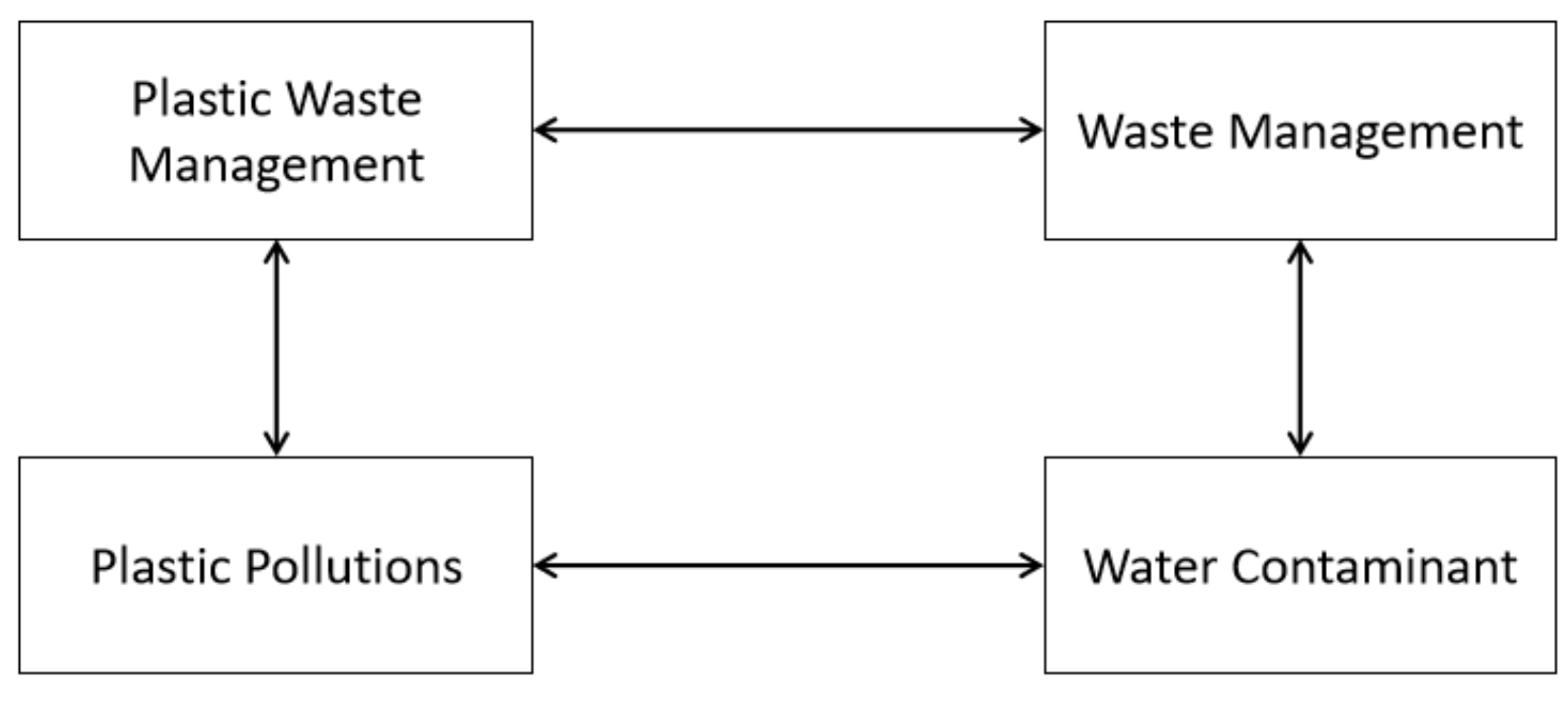
| Description | Results | Recent Contribution (2022) |
|---|---|---|
| Main information | ||
| Timespan | 1992–2022 | |
| Sources | 2063 | |
| Documents | 13,103 | 2256 |
| Document types | ||
| Article | 10,700 | 1875 |
| Review article | 1358 | 325 |
| Proceeding paper | 954 | 22 |
| Meeting abstract | 144 | 1 |
| Editorial material | 134 | 18 |
| Early access | 86 | |
| Letter | 50 | 13 |
| Book chapters | 20 | |
| Data paper | 10 | 2 |
| Correction | 4 | |
| News item | 4 | |
| Retracted publication | 4 | |
| Software review | 1 | |
| Document contents | ||
| Keywords plus | 14,073 | |
| Author’s keywords | 24,994 | |
| Authors | ||
| Authors | 46,044 | 200 |
| Author appearances | 40,340 | |
| Authors of single-authored documents | 3507 |
Disclaimer/Publisher’s Note: The statements, opinions and data contained in all publications are solely those of the individual author(s) and contributor(s) and not of MDPI and/or the editor(s). MDPI and/or the editor(s) disclaim responsibility for any injury to people or property resulting from any ideas, methods, instructions or products referred to in the content. |
© 2023 by the authors. Licensee MDPI, Basel, Switzerland. This article is an open access article distributed under the terms and conditions of the Creative Commons Attribution (CC BY) license (https://creativecommons.org/licenses/by/4.0/).
Share and Cite
Rinanda, R.; Sun, Y.; Chang, K.; Sulastri, R.; Cui, X.; Cheng, Z.; Yan, B.; Chen, G. Plastic Waste Management: A Bibliometric Analysis (1992–2022). Sustainability 2023, 15, 16840. https://doi.org/10.3390/su152416840
Rinanda R, Sun Y, Chang K, Sulastri R, Cui X, Cheng Z, Yan B, Chen G. Plastic Waste Management: A Bibliometric Analysis (1992–2022). Sustainability. 2023; 15(24):16840. https://doi.org/10.3390/su152416840
Chicago/Turabian StyleRinanda, Rizki, Yunan Sun, Keke Chang, Rini Sulastri, Xiaoqiang Cui, Zhanjun Cheng, Beibei Yan, and Guanyi Chen. 2023. "Plastic Waste Management: A Bibliometric Analysis (1992–2022)" Sustainability 15, no. 24: 16840. https://doi.org/10.3390/su152416840







